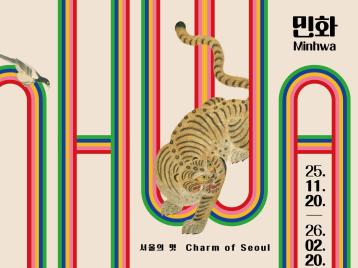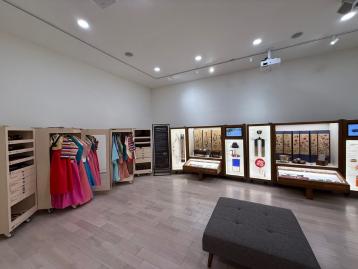EVENTS
-
K-Art Song Storytelling Workshop: Re-imagining Peace and Humanity Event Date Dec 11, 2025
Join us at the Korean Cultural Center Washington, D.C. (KCCDC) for a K-Art Song Storytelling Workshop: Re-imagining Peace and Humanity, a performance, discussion, and workshop at the intersection of traditional Korean music and poetry, presented in partnership with the K-Art Song Cultural Bridge Project. Experience live performances of Korean art songs, a genre known in Korean as gagok (가곡), that synthesize music and poetry with lyrical storytelling that reflects the complex modern history of the Korean Peninsula. Through collaborative narrative discourse with participants, this workshop intends to not only introduce the genre’s unique artistry but to awaken a collective sense of compassion and shared moral imagination, inviting listeners to re-imagine global peace together. Art songs, also known as Lied music, are a traditional form of sung poetry. In Korea, this operatic, classically-minded genre adapts a European concept with Korean aesthetics, expression, and musicality, often integrating works by influential 20th century Korean poets like independence activist Yun Dong-ju (1917-1945) and others. Through the “K-Art Song” medium, this event aims to evoke sound- and emotion-based dialogues and lyric-centered conversations. Participants are invited to join in this collaborative process by sharing their own experiences, co-creating stories of empathy and cultural solidarity on the path toward peace. K-Art Song Storytelling Workshop: Re-imagining Peace and Humanity Thursday, December 11, 2025 at 6:00 PM Korean Cultural Center Washington, D.C. Free with an RSVP (below) RSVP FOR THIS EVENT! About the K-Art Song Cultural Bridge Project The K-Art Song Cultural Bridge Project, affiliated with the Narrative Transformation Lab at the Carter School, seeks to cultivate shared experiences of the narratives embedded in Korean art song through storytelling and collective narrative discourse with international audiences. As a nexus model that interweaves live performance with participants’ narrative exchanges, the project aims to evoke empathy, foster moral imagination, and contribute to peacebuilding and community building—bridging intercultural narratives through creativity and imagination. By integrating artistic expression with dialogue-based methodologies, the K-Art Song Cultural Bridge Project explores how Korean art songs can be not only a cultural treasure but also a medium for cross-cultural communication—advancing empathy, fostering intercultural understanding, and contributing to sustainable peace. The K-Art Song Cultural Bridge Project connects emerging young professionals, composers, researchers, and storytellers across Korea, the United States, and a wider global community, cultivating a network dedicated to creative peace advocacy, collaborative learning, and inclusive global engagement. For more about the organization, visit www.k-artsongculturalbridgeproject.org. Program Part 1: Fostering Imagination through Sound and Emotion Live Performances and Open Dialogue Self-portrait (Written by Yun Dong-ju, Composed by YoungJu Jung) Baritone David Maeng, Pianist Austin Reed Prologue (Written by Yun Dong-ju, Composed by YoungJu Jung) Bass Josh Slutsky, Pianist Austin Reed A Night for Counting Stars (Written by Yun Dong-Ju, Composed by YoungJu Jung) Soprano Nancy McClain, Tenor Ross Calvin, Pianist Austin Reed Part 2: Storytelling and Interweaving a Peace Narrative Storytelling, Live Performances, and Open Dialogue Bimok (Written by Hahn Myung Hee, Composed by Sungeun Jo) Soprano Nancy McClain, Soprano Julianne Kim, Mezzo-Soprano Rebecca Rock, Pianist Austin Reed Dream Road (Written by Kim Sowol, Composed by Sungeun Jo) Tenor Jiheon Sung, Tenor Ross Calvin, Soprano Nancy McClain, Soprano Julianne Kim, Pianist Austin Reed Part 3: Sharing Takeaways & Narrative Transformation Activity Closing Remark & Networking
Post Date Dec 02, 2025 -
Charm of Seoul, Minhwa: Wishes in Korean Folk Painting Event Period Nov 20, 2025 - Feb 20, 2026
The Korean Cultural Center Washington, D.C. (KCCDC) and the Seoul Museum of History proudly presents Charm of Seoul, Minhwa: Wishes in Korean Folk Painting, a new exhibition of rare original 19th and 20th century art works that reveal the personal history of Seoul through the aspirations and desires of its upper classes embedded in the popular genres’ symbolism and folk motifs. These iconic minhwa art genres would go on to inspire many quintessential cultural images of Korea even into the modern age, including the now-globally-recognized “derpy tiger” and magpie characters from the hit Netflix movie K-Pop Demon Hunters. This exhibition also includes a variety of contemporary and digital art riffs on these classical styles. Featured items are drawn from the Seoul Museum of History’s special traveling exhibition Charm of Seoul with a focus on classical minhwa, the traditional folk paintings which evolved alongside Seoul’s own history and culture during the heights of the late Joseon Dynasty era leading up to the 20th century. The exhibition is also part of Korea’s ongoing Touring K-Art Project, featuring unique content across the traditional and popular cultural spectrum, supported by the Ministry of Culture, Sports and Tourism (MCST) and the Korea Foundation for International Cultural Exchange (KOFICE). In total the exhibition features around 20 works, including traditional and contemporary minhwa paintings, painted ceramics, other pieces from the museum’s collection, and a digital media folding screen from the National Museum of Korea. Through these exhibits and media works, visitors can gain a deeper understanding of Korean home life, decorative art, and traditional culture. The exhibition goes on display to the public November 20, 2025 through February 20, 2026 at the KCCDC and launches with a public opening reception and introduction by museum officials at the KCCDC on Thursday, November 20 at 6:00 p.m. (RSVP required). Attendees at the opening will also have a chance to enter a drawing for special prizes. Charm of Seoul, Minhwa: Wishes in Korean Folk Painting Exhibition Dates: November 20, 2025 – February 20, 2026 Opening Reception & Talk: Thursday, November 20 at 6:00 p.m Korean Cultural Center Washington, D.C. (2370 Massachusetts Ave. NW) Thank you for your interest! This event has reached maximum capacity, but spaces may re-open up if others cancel. Please use the link below to check the status. The exhibition will also remain open to walk-in visitors through February 20, 2026. RSVP LINK About the Exhibition Charm of Seoul, Minhwa: Wishes in Korean Folk Painting is presented in three thematic sections that tell an intimate and ongoing story that has been centuries in the making. Seoul’s Minhwa: The Blooming Wishes of Home presents fine examples of minhwa paintings that were historically made to order and spread from boutique stores to the homes of the city’s ordinary residents in the 18th and 19th centuries. Within a house, a minhwa painting was more than just a decorative picture: it expressed a longing for fortune and well-being across a variety of thematic genres: pyeongsaengdo (paintings of life’s celebrations) for a long, blessed life from birth; hojakdo (paintings of tigers and magpies) for protection from diseases and malicious intent; chaekgado (paintings of bookshelves) for espousing respect for the noble class and dreams of climbing the social ladder; eohaedo (paintings of fish and crabs) for wealth and fertility; and gammoyeojaedo (paintings of altars) for heavenly blessings through filial piety. The second section, Minhwa: The Wishes Blooming Today, highlights contemporary minhwa, reborn within Seoul and across Korea as a language of contemporary art that reinterprets tradition. Modern artists reinterpret symbolic motifs such as chaekgeori (images of books), tigers, magpies, lotus flowers, and fish with contemporary sensibilities, wit, and freedom, expressing personal desires and messages of happiness and peace that reflect the enduring yearning for auspiciousness from the Joseon period to modern society. In the third section, Yoonseul Space—drawing on the Korean word yoonseul, indicating the shimmering reflection of light on waves—media artworks express the continuity of Seoul’s traditions and cultural heritage through time. 호작도, 한지, 20세기, 서울역사박물관 소장 Hojakdo: Tiger and Magpie Painting Paint on mulberry paper, 20th century, Seoul Museum of History Collection 책가도, 한지, 20세기초, 서울역사박물관 소장 Folding Screen of Chaekgado (Scholar’s Accouterments) Paint on mulberry paper, early 20th century, Seoul Museum of History Collection 감모여재도, 한지, 조선, 서울역사박물관 소장 Gammoyeojaedo Ancestral Shrine Painting Paint on mulberry paper, Joseon Dynasty, Seoul Museum of History Collection 어해도, 한지, 19세기, 서울역사박물관 소장 Fish and Crab Painting Paint on mulberry paper, 19th Century, Seoul Museum of History Collection 백자청화기명절지문병, 도자기, 19세기, 서울역사박물관 소장 Blue and White Porcelain Vase with Scholar's Objects Design Porcelain, 19th century, Seoul Museum of History Collection
Post Date Nov 14, 2025 -
Explore Korean Culture Box at the Korean Cultural Center Washington, D.C.
We are excited to introduce the newly established cultural boxes in the Media Room on the first floor of the Korean Cultural Center Washington, D.C. The displays include the Annyeong (안녕) Box, which introduces the Korean alphabet and allows participants to experience writing in 'Hangeul'; the Sarangbang (사랑방) Box, highlighting men’s quarters in the Joseon period centered around the 'seonbi' (Confucian scholar) culture; the Anbang (안방) Box, showcasing women’s quarters in the Joseon period centered around the 'gyubang' (boudoir) culture; and the Hanbok (한복) Box, a hands-on display where participants can try on traditional Korean clothing.
Post Date Nov 10, 2025 -
Discover Doljabi: Celebrating the Korean First Birthday Tradition with Authors Ginger Park and Frances Park Event Date Nov 01, 2025
Join Ginger Park and Frances Park, authors of the children’s book My Sister’s Doljabi, for a special K-Culture Talk exploring and celebrating Korea’s first birthday tradition. Discover the cultural significance of the one-year birthday milestone, dol (돌), and the meaning of objects babies choose during doljabi (돌잡이), through personal stories from the authors. The Park sisters will also introduce their enchanting new book, My Sister’s Doljabi, and explain how Korean culture inspired their storytelling. Participants will also have a chance to enjoy hands-on activities, including a doljabi experience, tasting traditional Korean rice cakes (tteok) served at a first birthday, and trying on traditional Korean hanbok attire. Families attending with children will also receive a complimentary copy of My Sister’s Doljabi (while supplies last). The program will conclude with a book signing and the opportunity for guests to meet the authors. Discover Doljabi: Celebrating the Korean First Birthday Tradition with Authors Ginger Park and Frances Park Date & Time: Saturday, Nov. 1, 2025 | 1:00 – 3:00 PM Location: Korean Cultural Center Washington, D.C. (2370 Massachusetts Ave NW, Washington, DC 20008) RSVP FOR THIS EVENT! About the Authors Ginger Park is a Korean American author of many children's books. She has received multiple awards for her work, including the International Reading Association’s Children’s Book Award, the IRA-CBC Teachers’ Choice Award, the Notable Books for a Global Society Award, the Paterson Prize Book Award for Young Readers, and the Bank Street Book Award, among others. She lives in the suburbs of Washington, D.C. Frances Park is a Korean American author of books for children and adults. She has received multiple awards for her work, including the International Reading Association’s Children’s Book Award, the IRA-CBC Teachers’ Choice Award, the Notable Books for a Global Society Award, the Paterson Prize Book Award for Young Readers, and the Bank Street Book Award, among others. She lives in the suburbs of Washington, D.C. For more, visit the authors' website at www.parksisters.com. Excerpt from My Sister’s Doljabi by Ginger Park and Frances Park The history of dol—the first-birthday celebration in Korea—goes back centuries. Like the great-grandmother in Binna’s Birthday, our mother, who was born in 1930, lost four of her nine brothers and sisters—all before their first birthdays. Our mother was the only sibling who would go on to celebrate her palsun (80th birthday), and many more birthdays. Nowadays, with infant mortality very low, the objects in doljabi sets often represent careers, such as a gavel for judge, stethoscope for doctor, cellphone for engineer, and golf club or baseball bat for athlete. Still, dol remains the most important birthday for Koreans all around the world.
Post Date Oct 20, 2025 -
Explore 'Ssireum (씨름)', Korean traditional wrestling at the Korean Cultural Center Washington, D.C. Event Period Oct 15, 2025 - Nov 30, 2025
We are excited to introduce the newly established “Ssireum” display in the Experience Room on the first floor of the Korean Cultural Center Washington, D.C. The wall features a video explanation of the sport, a bull-shaped trophy awarded to Ssireum champions, a “satba” cloth belt tied around the waist and one thigh of each competitor, and much more.
Post Date Oct 15, 2025





